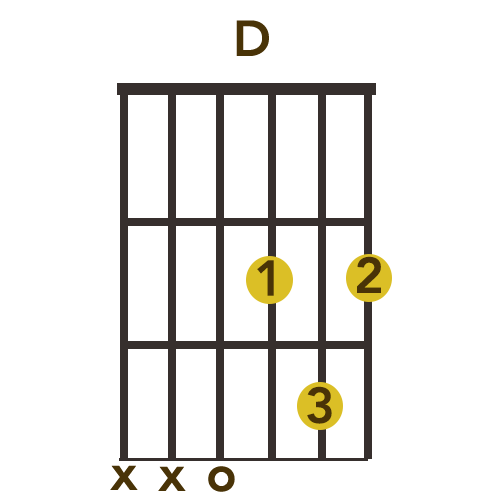D Chord Variations

Last week on my Instagram, I posted a video of a medley I’ve been jamming on pretty much ever since I picked up the guitar. It’s grown in complexity over time, as I like to throw in as many pull on and offs, hammer ons and slides as I can (that’s the fun of it!), but it still remains built on VERY simple chord shapes.
Here’s the video to give you an idea of what we’re talking about.
Sounds kind of tricky right? While the techniques used to play each note have been practiced over time, the actual chords making up this melody are ones you can learn and start your own jam session with TODAY. So, let’s learn them!
They are all variations of the D major chord.
Which you may or may not know yet. Either way, here’s it’s chart and a photo to jog your memory:
Before I learned ANYTHING about music theory, and how variations of chords were even a thing, I was playing around with each new chord I learned and what it sounded like when I added a note here or dropped a note there. At the time, I didn’t know what I was doing had a name or belonged within the realm of ‘proper playing,’ I just knew that it sounded good.
Chord variations are one of my favourite elements of composing melodies/jamming.
It’s a super easy way to add a new flavour or twist to an already existing chord. Even the smallest change- like adding a single note or taking one away- can completely alter your sound. As far as theory goes, not only are you altering a chord, but you are playing a completely new one; unique itself.
It’s pretty powerful stuff, especially as a beginner, knowing you can take one chord and turn it into several new ones- all by single one note changes. The experimentation here is endless!
You can apply one note changes like this with ANY chord. Today we’re going to look at D major. These are my favourite D major chord variations (and yes, there are even more than this- for another post!)
Variation 1: Add the pinky!
The ‘sus’ in this D chord variation’s name stands for suspended. And when you play it, you can hear it doing just that. By adding your pinky on the 3rd fret high E, your chord is raised with a higher note. It’s a sound of reaching. Very cool melodic addition.
NOTE: As you can see in the diagram you DON’T need to keep your middle finger on fret 2 of your high E string. However, I’m in the camp of making as little movement as possible between transitions, so I just leave my middle finger where it is. Odds are I’m coming back to it, and it doesn’t make a difference in sound. You can simply lift that finger up if you prefer.
Variation 2: Lift middle!
Although this chord is also suspended, it brings a different sound. Not the obvious ‘reaching’ tone suspended chords usually bring. But this one is restless in a different way. It’s reaching in a different direction. It’s one of those middle landing chords that is evidently leading somewhere. For this one, simply lift your middle finger from the D major chord shape. Love this for a transitional chord.
Variation 3: Lift pointer!
This is one of my favourites! Very inquisitive tone. As for its name, I’ve gotten some mixed results, but based on the notes in this structure (all notes in D major + G), we’re gonna call it a D/G. What this means is, we’re playing all the appropriate notes for a D major chord, but adding a G note on top. This is a ‘slash’ chord. It’s written D/G and read G over D. All of that for just lifting your pointer finger- can you believe it?!
Try playing these three different chord variations in between D major and each other. You’ll see how unique they sound and how well they complement each other. You can play them as separate chords or you can utilize the one finger changes in techniques like hammer ons and pulls offs while playing D major. Either way, it’s sure to add complexity and nuance to your playing!








